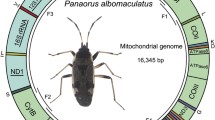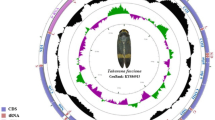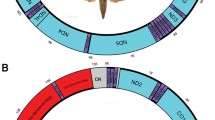Abstract
We describe the complete mitochondrial genomes of the green lacewing species Chrysoperla nipponensis (Okamoto, 1914) and Apochrysa matsumurae Okamoto 1912 (Neuroptera: Chrysopidae). The genomes were 16,057 and 16,214 bp in size, respectively, and comprised 37 genes (13 protein coding genes, 22 tRNA genes and two rRNA genes). A major noncoding (control) region was 1,244 bp in C. nipponensis and 1,407 in A. matsumurae, and the structure was simpler than that reported in other Neuroptera, lacking conserved blocks or long tandem repeats. The overall arrangement of genes was almost the same as that found in most arthropod mitochondrial genomes, with the one exception of a tRNA rearrangement to tRNA-Cys–tRNA-Trp–tRNA-Tyr, rather than the plesiomorphic tRNA-Trp–tRNA-Cys–tRNA-Tyr. A high A + T content (78.89 and 79.02%, respectively), A + T-rich codon bias, and a mismatch between the most-used codon and its corresponding tRNA anticodon were observed as a typical feature of the insect mitochondrial genome.

Similar content being viewed by others
Abbreviations
- CO1, CO2, and CO3:
-
Cytochrome oxidase subunit I, II, and III genes, respectively
- CytB:
-
Cytochrome b gene
- ATP6 and ATP8:
-
ATP synthase F0 subunit 6 and 8 genes
- ND1, ND2, ND3, ND4, ND4L, ND5, ND6:
-
NADH dehydrogenase subunit 1–6 and 4L genes
- srRNA and lrRNA:
-
Small and large subunit (12S and 16S) ribosomal RNA genes; transfer RNA genes are designated by the three-letter or single-letter code for the specified amino acid, such as tRNA-Cys or C
References
Avise JA, Aronold J, Ball RM, Bermingham E, Neigel JE, Reeb CA et al (1987) Intraspecific phylogeography: the mitochondrial DNA bridge between population genetics and systematics. Annu Rev Ecol Syst 18:489–522
Boore JL, Macey JR, Medina M (2005) Sequencing and comparing whole mitochondrial genomes of animals. Methods Enzymol 395:311–348
Wilson AC, Cann RL, Carr SM, George M, Gyllensten UB, Helm-Bychowski KM et al (1985) Mitochondrial DNA and two perspectives on the evolutionary genetics. Biol J Linn Soc 26:375–400
Boore JL, Collins TM, Stanton D, Daehler LL, Brown WM (1995) Deducing the pattern of arthropod phylogeny from mitochondrial DNA rearrangements. Nature 376:163–165
Boore JL, Lavrov DV, Brown WM (1998) Gene translocation links insects and crustaceans. Nature 392:667–668
Boore JL (1999) Animal mitochondrial genomes. Nucleic Acids Res 27:1767–1780
Curole JP, Kocher TD (1999) Mitogenomics: digging deeper with complete mitochondrial genomes. Trends Ecol Evol 14:394–398
Feijão PC, Neiva LS, Azeredo-Espin AML, Lessinger AC (2006) AMiGA: the arthropodan mitochondrial genomes accessible database. Bioinformatics 22:902–903
McEwen P, New TR, Whittington AE (eds) (2001) Lacewings in the crop environment. Cambridge University Press, Cambridge
Henry CS, Brooks SJ, Thierry D, Duelli P, Johnson JB (2001) The common green lacewing (Chrysoperla carnea s. lat.) and the sibling species problem. In: McEwen P, New TR, Whittington AE (eds) Lacewings in the crop environment. Cambridge University Press, Cambridge, pp 29–42
Henry CS, Wells MM (2007) Can what we don’t know about lacewing systematic hurt us? A cautionary tale about mass rearing and release of “Chrysoperla carnea” (Neuroptera: Chrysopidae). Am Entomol 53:42–47
Henry CS, Wells MM, Simon C (1999) Convergent evolution of courtship songs among cryptic species of the carnea-group of green lacewings (Neuroptera: Chrysopidae: Chrysoperla). Evolution 53:1165–1179
Lourenço P, Brito C, Backeljau T, Thierry D, Ventura MA (2006) Molecular systematic of the Chrysoperla carnea group (Neuroptera: Chrysopidae) in Europe. JZS 44:180–184
Cameron SL, Sullivan J, Song H, Miller KB, Whiting MF (2009) A mitochondrial genome phylogeny of the Neuropterida (lace-wings, alderflies and snakeflies) and their relationship to the other holometabolous insect orders. Zool Scr 38:575–590
Beckenbach AT, Stewart JB (2009) Insect mitochondrial genomics 3: the complete mitochondrial genome sequences of representatives from two neuropteroid orders: a dobsonfly (order Megaloptera) and a giant lacewing and an owl fly (order Neuroptera). Genome 52:31–38
Hua J, Li M, Dong P, Xie Q, Bu W (2009) The mitochondrial genome of Protohermes concolorus Yang et Yang 1988 (Insecta: Megaloptera: Corydalidae). Mol Biol Rep 36:1757–1765
Aspöck U (2002) Phylogeny of the Neuropterida (Insecta: Holometabola). Zool Scr 31:51–55
Taki H, Kuroki S, Nomura M (2005) Taxonomic diversity within the Japanese green lacewing, Chrysoperla carnea (Neuroptera: Chrysopidae), identified by courtship song analyses and crossing tests. J Ethol 23:57–61
Haruyama N, Mochizuki A, Duelli P, Naka H, Nomura M (2008) Green lacewing phylogeny, based on three nuclear genes (Chrysopidae, Neuroptera). Syst Entomol 33:275–288
Simon C, Frati F, Beckenbach A, Crespi B, Liu H, Flook P (1994) Evolution, weighting, and phylogenetic utility of mitochondrial gene sequences and a compilation of conserved polymerase chain reaction primers. Ann Entomol Soc Am 87:651–701
Yagi T, Sasaki G, Takabe H (1999) Phylogeny of Japanese papilionid butterflies inferred from nucleotide sequences of the mitochondrial ND5 gene. J Mol Evol 48:42–48
Croizer YC, Koulianos S, Croizer RH (1991) An improved test for Africanized honeybee mitochondrial DNA. Experientia 47:968–969
Gordon D, Abajian C, Green P (1998) CONSED: a graphical tool for sequence finishing. Genome Res 8:195–202
Wyman SK, Jansen RK, Boore JL (2004) Automatic annotation of organellar genomes with DOGMA. Bioinformatics 20:3252–3255
Perna NT, Kocher TD (1995) Patterns of nucleotide composition at fourfold degenerate sites of animal mitochondrial genomes. J Mol Evol 41:353–358
Stewart JB, Beckenbach AT (2005) Insect mitochondrial genomics: the complete mitochondrial genome sequence of the meadow spittlebug Philaenus spumarius (Hemiptera: Auchenorrhyncha: Cercopoidae). Genome 48:46–54
Clay DO, Wolstenholme DR (1985) The mitochondrial DNA molecule of Drosophila yakuba: nucleotide sequence, gene organization, and genetic code. J Mol Ecol 22:252–271
Flook PK, Rowell CH, Gellissen G (1995) The sequence, organization, and evolution of the Locusta migratoria mitochondrial genome. J Mol Evol 41:928–941
Hickerson MJ, Cunningham CW (2000) Dramatic mitochondrial gene rearrangements in the hermit crab Pagurus longicarpus (Crustacea, anomura). Mol Biol Evol 17:639–644
Nardi F, Carapelli A, Fanciulli PP, Dallai R, Frati F (2001) The complete mitochondrial DNA sequence of the basal hexapod Tetrodontophora bielanensis: evidence for heteroplasmy and tRNA translocations. Mol Biol Evol 18:1293–1304
Morlais I, Severson DW (2002) Complete mitochondrial DNA sequence and amino acid analysis of the cytochrome c oxidase subunit I (COI) from Aedes aegypti. DNA Seq 13:123–127
Krzywinski J, Grushko OG, Besansky NJ (2006) Analysis of the complete mitochondrial DNA from Anopheles funestus: an improved dipteran mitochondrial genome annotation and a temporal dimension of mosquito evolution. Mol Phylogenet Evol 39:417–423
Oliveira MT, Azeredo-Espin AML, Lessinger AC (2005) Evolutionary and structural analysis of the cytochrome c oxidase subunit I (COI) gene from Haematobia irritans, Stomoxys calcitrans and Musca domestica mitochondrial DNA. DNA Seq 16:156–160
Oliveira MT, Barau JG, Junqueira ACM, Feijão PC, Da Rosa AC, Abreu CF, Azeredo-Espin AML, Lessinger AC (2008) Structure and evolution of the mitochondrial genomes of Haematobia irritans and Stomoxys calcitrans: the Muscidae (Diptera: Calyptratae) perspective. Mol Phylogenet Evol 48:850–857
Francino MP, Ochman H (1997) Strand asymmetries in DNA evolution. Trends Genet 13:240–245
Hassanin A, Leger N, Deutsch J (2005) Evidence for multiple reversals of asymmetric mutational constraints during the evolution of the mitochondrial genome of metazoa, and consequences for phylogenetic inferences. Syst Biol 54:277–298
Bulmer M (1987) Coevolution of codon usage and transfer RNA abundance. Nature 325:728–730
Reyes A, Gissi C, Pesole G, Saccone C (1998) Asymmetrical directional mutation pressure in the mitochondrial genome of mammals. Mol Biol Evol 15:957–966
Saccone C, De Giorgi C, Gissi C, Pesole G, Reyes A (1999) Evolutionary genomics in metazoa: the mitochondrial DNA as a model system. Gene 238:195–209
Author information
Authors and Affiliations
Corresponding author
Additional information
All authors contributed equally to the study.
Y. Sato—JSPS Research Fellow.
Rights and permissions
About this article
Cite this article
Haruyama, N., Mochizuki, A., Sato, Y. et al. Complete mitochondrial genomes of two green lacewings, Chrysoperla nipponensis (Okamoto, 1914) and Apochrysa matsumurae Okamoto, 1912 (Neuroptera: Chrysopidae). Mol Biol Rep 38, 3367–3373 (2011). https://doi.org/10.1007/s11033-010-0444-0
Received:
Accepted:
Published:
Issue Date:
DOI: https://doi.org/10.1007/s11033-010-0444-0




